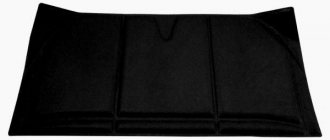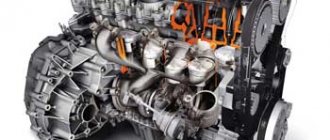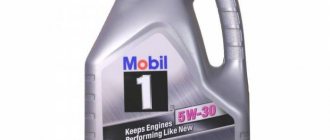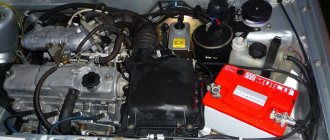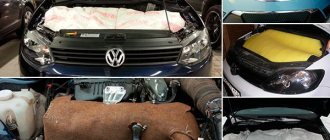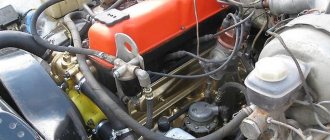There is a huge amount of talk and debate about engine insulation. Some fully support this idea, others are categorically against it, considering insulation not only useless, but also very dangerous.
The situation is truly ambiguous and should be dealt with in more detail. First, it’s worth understanding why the engine is insulated and whether it needs to be done. If the decision is made, then it remains to select the appropriate material to perform such procedures.
Please note that insulation is carried out only for the winter period and the material should be removed when warmer weather arrives. Otherwise, this will provoke overheating of the motor with all the ensuing consequences.
Why do you insulate the engine compartment, and is it worth doing?
In theory, the answer to the question of whether it is really necessary to insulate the engine in the engine compartment of a car in winter is extremely obvious. Yes, this is how you need to do it.
Theorists attribute this to the fact that in winter the engine cools down greatly, the oil thickens, which is why when starting a cold internal combustion engine, the engine elements are left without proper lubrication until the operating temperature is reached. And this is detrimental to the power unit.
But now we should move on to practice. Not everything is so clear here anymore.
If it's winter outside, you need to answer 4 main questions. They will allow you to understand whether it is really necessary to insulate the engine compartment and whether the resulting result is worth the effort or not.
- Will insulation reduce the load on engine components during a cold start? It all depends on the specific situation. If the car sits all night, then with or without insulation the oil will harden. The start-up will be no different, regardless of the presence or absence of a car blanket. If the car is operated in the go-stand-go mode, then the insulation will give a good result. In this case, it makes sense to put it under the hood.
- Are there materials suitable for such purposes? Yes, and the range is quite extensive. Classic felt, which our grandfathers used, has faded into the background. There are much more effective and easy-to-use materials.
- Will insulation cause problems in the operation of the internal combustion engine? It’s difficult to answer clearly here. The main thing is to build on the temperature in your region. How and with what you heat the internal combustion engine also plays a big role. Sometimes the effect is truly disastrous. But with the right approach, the engine will work well and cool sufficiently without having time to cool down too much.
- Can insulation cause a fire? Yes, there is such a risk. Therefore, it is important to choose materials that do not burn. You should also lay the blanket correctly to prevent contact with hot surfaces. Here it is optimal to use materials that only smolder and have dielectric properties.
To summarize, we can draw the following conclusions. There really is a point in insulation. But only if the winter in your region is really cold. When only a couple of days during the entire winter the thermometer barely reaches -15-20 degrees, insulation will become a pointless exercise.
If in winter it is stable outside -20-30 degrees Celsius, then covering the engine definitely won’t hurt. Moreover, this will be relevant for those who travel by car often and in short bursts. The oil will still thicken overnight, regardless of whether there is insulation or not. So now draw conclusions based on your situation.
Advantages and disadvantages of a car blanket
The experience of using car insulation goes back to the old days, when cars had carburetors and 76-octane gasoline was used everywhere. Naturally, such cars warmed up very slowly in cold weather and cooled down, accordingly, quickly. However, these days are long gone, cars have become fuel-injected, and gasoline has become higher octane. Accordingly, less time is spent warming them up.
Currently, there are three types of insulation - engine, radiator and battery. Let's start the review with the most common one - a “blanket” for the engine. The advantages of using it are as follows:
- The engine warms up faster at negative temperatures . This fact is ensured by the heat shield effect, which prevents heat from the engine from rising and spreading throughout the engine compartment and heating the hood.
- After stopping the power unit, the latter remains warm for a long time . This becomes relevant in case of short stops, then it is easier and easier to start the car.
- Thanks to the use of insulation for the car hood, the warm-up time is reduced . This follows from the first point of this list.
- If the car is equipped with automatic temperature heating, the number of engine starts per night is reduced by 1.5...2 times (for example, from 5 to 3).
- No ice forms on the surface of the hood . This becomes possible due to the fact that the heat from the motor does not heat it up, and accordingly, moisture from the outside does not crystallize.
- The insulation slightly reduces the noise load both inside the car and outside.
Before describing the shortcomings, it is necessary to clarify several nuances on which they may depend. In particular, the insulation works differently with turbocharged and naturally aspirated engines, at different temperatures (for example, -30° and -5°C), under different driving conditions (in the city cycle and on the highway), when taking air from the radiator grille or from the engine compartment. The combination of these and other objective conditions gives different results from using a car blanket for engines, batteries and radiators. That is why such blankets can often lead to the following troubles:
- overheating of the engine, which in itself is bad, and can threaten the failure of its individual parts;
- at a relatively high temperature (about -5°C...-3°C), the ignition coils and/or the insulation of high-voltage wires may be damaged;
- if warm air enters the system, there is a risk of delayed ignition, which may increase fuel consumption;
- as a rule, when using insulation for a car, engine power drops, naturally, fuel saving is out of the question;
- If you buy a low-quality blanket for your engine, it may catch fire!;
- Most modern insulation for a car battery, its engine or radiator have a short service life - about one to two years.
Is it worth using a car blanket?
Using a car blanket
Thus, the decision about whether it is worth buying engine insulation or not depends on many factors. In particular, if you live in latitudes where in winter the temperature drops to -25°C or lower, and the engine in your car takes a long time to warm up, then yes, it makes sense to think about purchasing. But if the winter temperature in your area rarely drops below -10°C, and you own a modern foreign car with a good heating system, then you hardly need to worry about a car blanket.
If you decide to buy a car blanket, then buy a product made of non-flammable material, and from trusted sellers, otherwise there is a risk of the insulation catching fire!
What to use for insulation
There is one important nuance here. There are 2 ways to insulate the engine compartment. Namely:
- covering the engine itself;
- hood insulation.
And here various materials are used. Speaking about the best way to insulate a car for the coming winter and what to put under the hood, it’s worth looking at 2 situations separately.
The motor is covered mainly in 2 ways:
- Insulate the engine with regular felt. A widely used insulation material that is often installed on the engine. Attracts with its price and good efficiency. Some people argue that felt cannot be used to insulate a car engine. In reality, there are no compelling arguments against this particular material. Like any other type of covering, felt can cause overheating and smoldering. But this is more likely due to non-compliance with the technology, and not with the material itself. If you want to save money, you can use felt.
- Car blanket. These are ready-made solutions that are sold in car dealerships. It is believed that they cope better with tasks such as engine insulation. You can argue endlessly. This depends on the quality of the car blanket and the materials used in its composition.
When choosing a material for covering an internal combustion engine, give preference only to non-flammable and dielectric materials.
To some extent, the car blanket is actually better. It is more efficient and designed for specific tasks. The popularity of felt is associated with its low cost.
There will be no problems installing a blanket or felt. You should choose a blanket that fits the size of your engine compartment (there are model car blankets for specific cars), or cut out the desired blank from felt. Then the material is simply laid down. There is no need to glue or fix anything.
At the same time, high-quality thermal insulation for a car hood is also important. To insulate the hood, you can use the following materials:
- Isoflex. Self-adhesive based on polyurethane foam filler. Covered with textiles, PVC, anti-adhesive films or PET. In addition to thermal insulation, it also has good sound insulation properties. The material is fireproof.
- Tiviplen. A good option to insulate the hood. On one side there is a self-adhesive base. It is made on the basis of polyethylene foam and has a gasoline-resistant coating. Available in thicknesses of 4, 8 and 15 mm. Even without foil it does its job perfectly. Does not absorb moisture and does not decompose. Withstands temperatures ranging from -40 to 70 degrees Celsius;
- Stizol. He's penofol. Made on the basis of polyethylene foam and complemented by a foil coating. Reflective surfaces create the effect of a thermos, which is why it is ahead of many competitors in thermal insulation. Does not conduct electricity, is very elastic, does not burn, is moisture resistant and environmentally friendly;
- Splen. Elastic insulation with foil coating. Available in sheets with a thickness of 3 to 10 mm;
- Izolon. It is inexpensive, but retains heat very effectively. The thicker the material, the more expensive it will be.
Each of the presented materials is perfect for covering the back side of the hood and achieving the necessary thermal insulation effect. Therefore, choose for yourself what you like best or is suitable for the price. Among them, isolon is considered the most budget-friendly solution.
The meaning of insulating the hood is quite simple and understandable. You need to clean the surface, cut out the blanks to the shape of the hood, and then carefully glue the material.
Additionally, it is not recommended to use glue. Use only the adhesive side of the insulation material.
The work is not difficult, but requires accuracy. As a result, you can insulate the hood in literally 1 hour.
Nuances of insulation of diesel engines
There shouldn’t be any special problems with how to properly insulate the engine for the winter with your own hands. It is enough to purchase the necessary materials and use them in accordance with their intended purpose.
At the same time, it would be fair to say that a diesel engine is more sensitive to low temperatures than a gasoline engine. This is due to increased requirements for the quality of lubricant and the characteristics of diesel fuel.
Therefore, doing the insulation of the hood and engine of a car with your own hands if you have a diesel engine should be done with special care. In this regard, experts give several recommendations:
- Take advantage of a high-quality and effective car blanket that fits the specific dimensions of your engine compartment. If the frost is severe, but the blanket only partially covers the internal combustion engine, this will not have any effect.
- The car blanket itself only partially solves the problem of motor oil solidifying. Therefore, it is almost pointless to use only it when it is -30 degrees outside.
- Additionally, insulation of the pipelines that lead from the fuel tank to the engine itself is required. For these purposes, it is effective to use foamed polyethylene with a thickness of 5 mm.
- The same material should be used to cover various cracks under the hood.
- It would be a good idea to insulate the radiator using suitable materials. The same sheets that were used to process the hood cover will also work.
A distinctive feature of diesel is that it is in greater need of comprehensive insulation. Gasoline analogs are simpler in this component.
How can you insulate an engine?
There are various ways to insulate a car engine, the most common of which are the following:
- Car blanket;
- Electric heating;
- Autonomous heater.
The choice of method for insulating a car engine depends both on the financial capabilities of its owner and on the climatic conditions of the region in which the car is used.
Warming the engine for the winter has been relevant since the advent of cars with gasoline engines, and therefore there are traditional methods, one of which is the use of a felt cape.
The principle of its operation is extremely simple - it is placed between the engine and the hood and, due to its heat-retaining properties, slows down the cooling of the engine after switching off, thereby ensuring that the fuel and lubricants in it thicken for as long as possible.
Car blanket for engine
A specialized car blanket is a modern analogue of a felt motor cover, and therefore does not have its disadvantages - it is made of non-flammable materials, and therefore the chance of it catching fire is extremely low.
It is a piece of fiberglass cut to the shape of the hood, which is the outer shell, under which there is some kind of non-flammable filler.
In addition, the materials from which the car blanket is made are not susceptible to chemical influences, so even contact with fuel, oil or other technical liquids will not contribute to their combustion.
An auto blanket is undoubtedly an effective tool, but there are also more technologically advanced ways to ensure the engine temperature necessary for normal operation in severe frosts, ensuring the desired result in almost any weather.
One of these methods is electrical pre-heating, with which the engine heats up to the desired temperature in a short time, which can significantly increase its operating life compared to a cold start.
Electric engine heating is powered by a 220V network and requires a nearby power source, and therefore its use is very limited.
The most serious disadvantage of this type of heating devices is the dependence on the power supply - since the device requires power from a 220V network, it can only be used close to a source of such power. Most often it is used in everyday life - it can be a garage or home parking.
Autonomous pre-heating for insulation
An autonomous preheating device is a more advanced device than an electric heating device operating from a centralized power supply network, and therefore its cost is slightly higher.
As you can understand from the name of the device, the autonomous pre-heater does not operate from the mains, but from the car battery, so it can be used anywhere, including in the event of an unforeseen situation on a long trip or other extreme conditions.
In addition, autonomous heating can be programmed to turn on several times during the night to maintain the required engine temperature.

